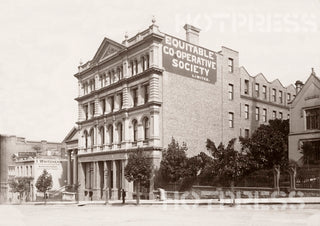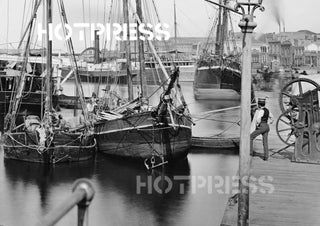1885 Collins Street - Equitable Co-operative Society Building (later Georges)
Description
This iconic building - known by most as "Georges" - was originally built for the Equitable Co-operative Society in 1883. Designed by architects John Grainger and Charles D'Ebro and built on land owned by Scots' Church, the new building was constructed in classical revival style in 1883 by David Mitchell for the Equitable Co-operative Society Ltd. (See it as it was when it became "Georges".)
The society soon went bankrupt, and land boom speculator and politician B.J. Fink had the building extended in 1887 through to Little Collins Street, with the alterations designed by architect David Christopher Askew (Fink commissioned Askew soon after to design the Block Arcade). Georges (founded by brothers William and Alfred George in 1880) moved in after a fire forced them to move from their original site further west in Collins Street in 1889, with "Georges" at 162 Collins Street soon becoming Melbourne's most exclusive shopping address.
Cox Brothers took over Georges from 1960-66, with David Jones Ltd buying the business in 1981. Sadly, Georges ceased trading after 115 years in 1995. Fortunately, the building survives and now houses a number of smaller specialist retailers. However, the shopping experience that once was "Georges" will never be seen again.
All text © HotPress
Photograph attributed to John William Lindt.
Notes from the State Library tell us that this image is "Looking across street towards four storey building built in Renaissance Revival style, name on side of building, columns and pediment of Baptist church just visible on left beside building. Architects Grainger & D'Ebro; built in 1884, it became Georges Department Store in 1889."
This is a digitally retouched reproduction of the original held by the State Library of Victoria. All prints are reproduced without the HOTPRESS watermarks.
Our team of conservators have worked on a high resolution digital image in order to remove blemishes and artifacts such as stains, mould, scratches and damage caused by the handling of the original. We strive to provide authentic representations of the original work that are suitable for enlargements that retain the tones and character of the original.
Description
This iconic building - known by most as "Georges" - was originally built for the Equitable Co-operative Society in 1883. Designed by architects John Grainger and Charles D'Ebro and built on land owned by Scots' Church, the new building was constructed in classical revival style in 1883 by David Mitchell for the Equitable Co-operative Society Ltd. (See it as it was when it became "Georges".)
The society soon went bankrupt, and land boom speculator and politician B.J. Fink had the building extended in 1887 through to Little Collins Street, with the alterations designed by architect David Christopher Askew (Fink commissioned Askew soon after to design the Block Arcade). Georges (founded by brothers William and Alfred George in 1880) moved in after a fire forced them to move from their original site further west in Collins Street in 1889, with "Georges" at 162 Collins Street soon becoming Melbourne's most exclusive shopping address.
Cox Brothers took over Georges from 1960-66, with David Jones Ltd buying the business in 1981. Sadly, Georges ceased trading after 115 years in 1995. Fortunately, the building survives and now houses a number of smaller specialist retailers. However, the shopping experience that once was "Georges" will never be seen again.
All text © HotPress
Photograph attributed to John William Lindt.
Notes from the State Library tell us that this image is "Looking across street towards four storey building built in Renaissance Revival style, name on side of building, columns and pediment of Baptist church just visible on left beside building. Architects Grainger & D'Ebro; built in 1884, it became Georges Department Store in 1889."
This is a digitally retouched reproduction of the original held by the State Library of Victoria. All prints are reproduced without the HOTPRESS watermarks.
Our team of conservators have worked on a high resolution digital image in order to remove blemishes and artifacts such as stains, mould, scratches and damage caused by the handling of the original. We strive to provide authentic representations of the original work that are suitable for enlargements that retain the tones and character of the original.

